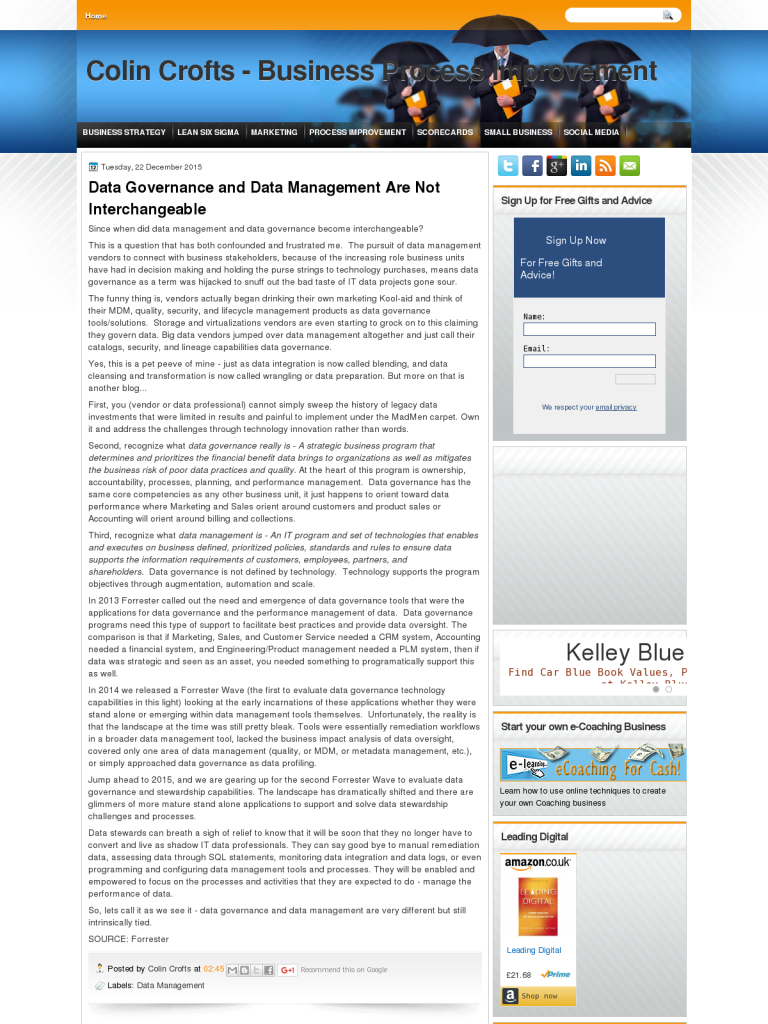Data Governance and Data Management Are Not Interchangeable
Blog: Colin Crofts - Business Process Improvement
Since when did data management and data governance become interchangeable?
This is a question that has both confounded and frustrated me. The pursuit of data management vendors to connect with business stakeholders, because of the increasing role business units have had in decision making and holding the purse strings to technology purchases, means data governance as a term was hijacked to snuff out the bad taste of IT data projects gone sour.
The funny thing is, vendors actually began drinking their own marketing Kool-aid and think of their MDM, quality, security, and lifecycle management products as data governance tools/solutions. Storage and virtualizations vendors are even starting to grock on to this claiming they govern data. Big data vendors jumped over data management altogether and just call their catalogs, security, and lineage capabilities data governance.
Yes, this is a pet peeve of mine – just as data integration is now called blending, and data cleansing and transformation is now called wrangling or data preparation. But more on that is another blog…
First, you (vendor or data professional) cannot simply sweep the history of legacy data investments that were limited in results and painful to implement under the MadMen carpet. Own it and address the challenges through technology innovation rather than words.
Second, recognize what data governance really is – A strategic business program that determines and prioritizes the financial benefit data brings to organizations as well as mitigates the business risk of poor data practices and quality. At the heart of this program is ownership, accountability, processes, planning, and performance management. Data governance has the same core competencies as any other business unit, it just happens to orient toward data performance where Marketing and Sales orient around customers and product sales or Accounting will orient around billing and collections.
Third, recognize what data management is – An IT program and set of technologies that enables and executes on business defined, prioritized policies, standards and rules to ensure data supports the information requirements of customers, employees, partners, and shareholders. Data governance is not defined by technology. Technology supports the program objectives through augmentation, automation and scale.
In 2013 Forrester called out the need and emergence of data governance tools that were the applications for data governance and the performance management of data. Data governance programs need this type of support to facilitate best practices and provide data oversight. The comparison is that if Marketing, Sales, and Customer Service needed a CRM system, Accounting needed a financial system, and Engineering/Product management needed a PLM system, then if data was strategic and seen as an asset, you needed something to programatically support this as well.
In 2014 we released a Forrester Wave (the first to evaluate data governance technology capabilities in this light) looking at the early incarnations of these applications whether they were stand alone or emerging within data management tools themselves. Unfortunately, the reality is that the landscape at the time was still pretty bleak. Tools were essentially remediation workflows in a broader data management tool, lacked the business impact analysis of data oversight, covered only one area of data management (quality, or MDM, or metadata management, etc.), or simply approached data governance as data profiling.
Jump ahead to 2015, and we are gearing up for the second Forrester Wave to evaluate data governance and stewardship capabilities. The landscape has dramatically shifted and there are glimmers of more mature stand alone applications to support and solve data stewardship challenges and processes.
Data stewards can breath a sigh of relief to know that it will be soon that they no longer have to convert and live as shadow IT data professionals. They can say good bye to manual remediation data, assessing data through SQL statements, monitoring data integration and data logs, or even programming and configuring data management tools and processes. They will be enabled and empowered to focus on the processes and activities that they are expected to do – manage the performance of data.
So, lets call it as we see it – data governance and data management are very different but still intrinsically tied.
Leave a Comment
You must be logged in to post a comment.








